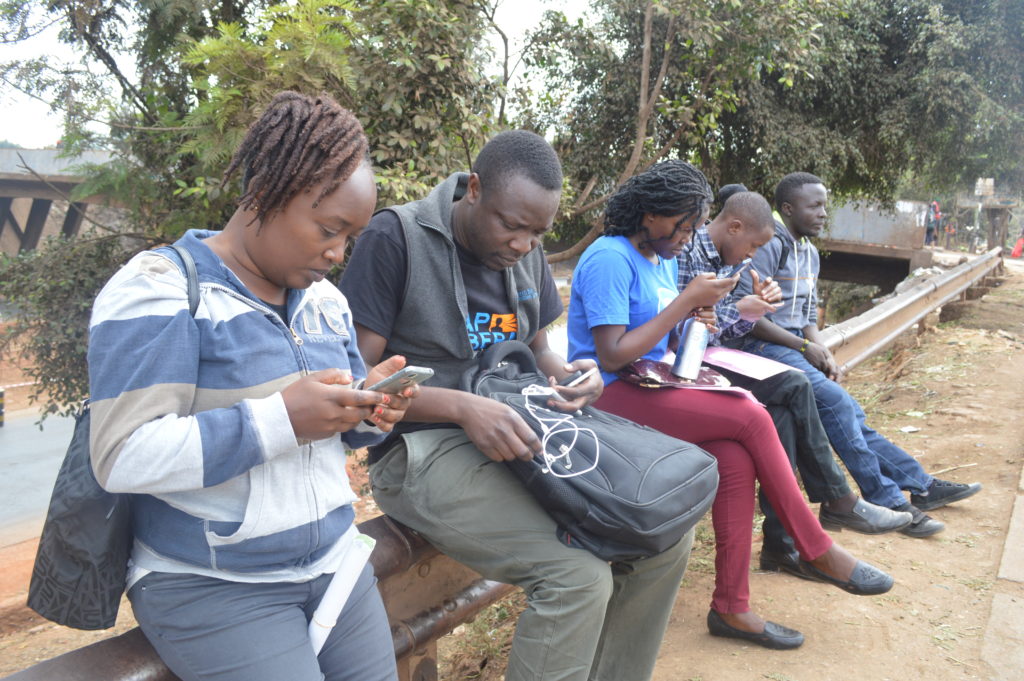
Open Schools Kenya is a great initiative that seeks to make data about schools available and meaningful to the public and stakeholders in the education sector through mapping. The idea initially started in Kibera and the rigorous mapping exercise saw slightly over 300 schools mapped in the region. What has followed ever since has been a success story. The mapping of schools has made it easier for parents to make informed choices when sending their children to school. The mapping of schools has also made it easier for the relevant authorities to know about and follow up with schools and contact them without having to hustle for their contact details like before.
Moving forward, Map Kibera was first in line to assist in the implementation of the same idea of mapping of schools in Kangemi with the generous support of Indigo Trust. Map Kibera offered training to participants from Kangemi to map their local schools, with support from many including the MP of Westlands Constituency, Hon.Timothy Wanyonyi, Evans Onchiri, the APBET (Alternative Provision of Basic Education) Coordinator for Kangemi, and the District Education Officer Julius Mburu.
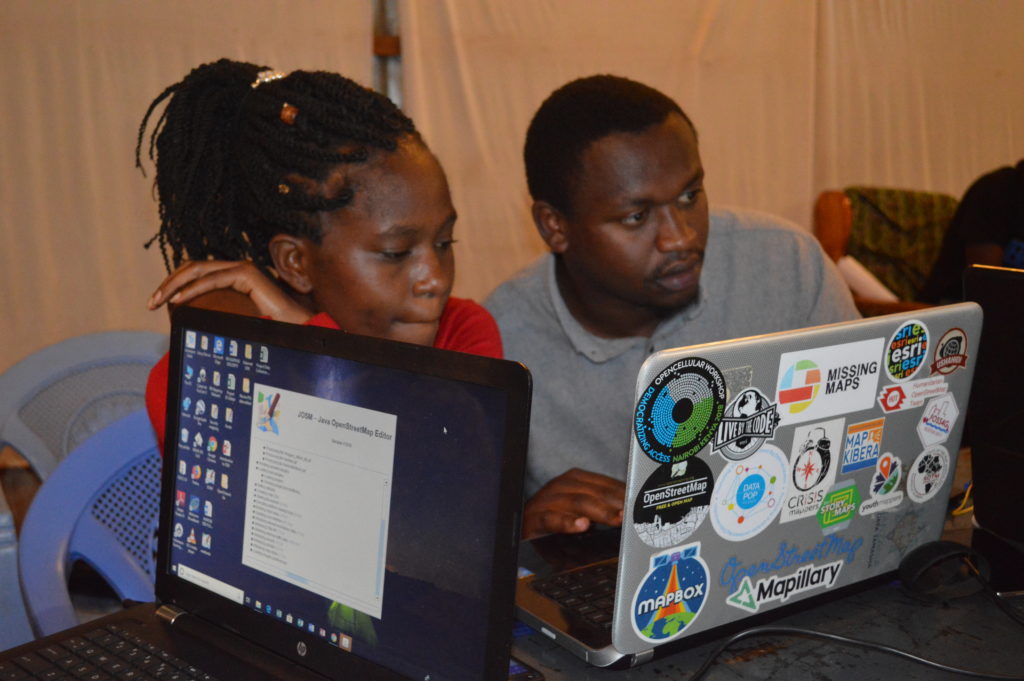
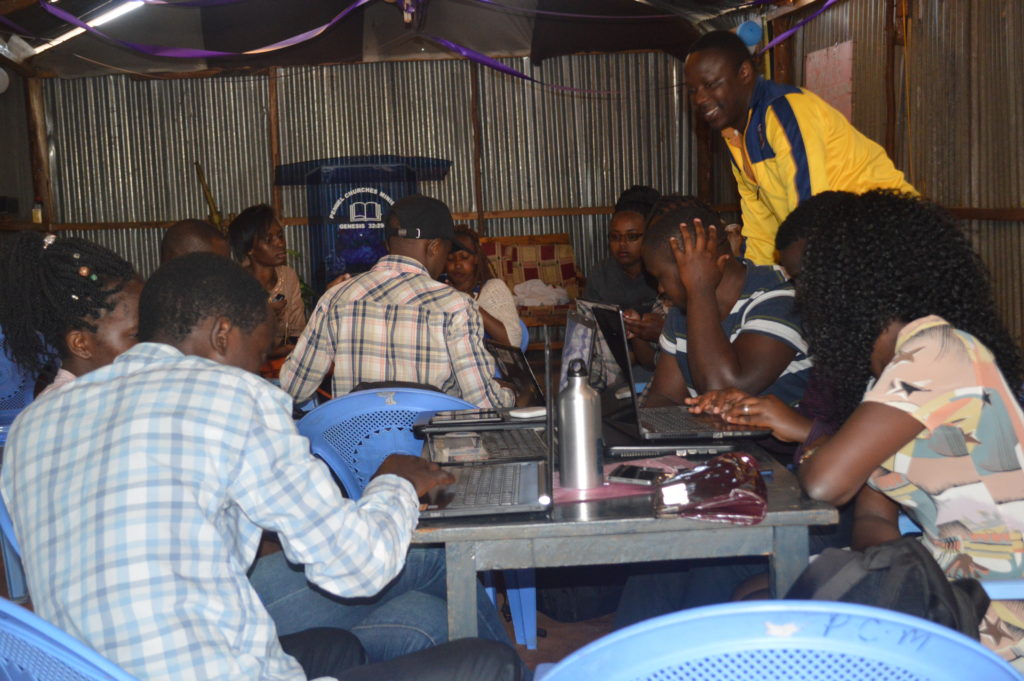 We had a total of twelve mappers with seven of them being locals from the region, and the rest from the Map Kibera team. Lead mapper from Kangemi was Sharon Adhiambo, who had previously worked with Map Kibera on trainings while a member of Youth Mappers at Moi University. The selected wards were Kangemi, Kitusuru, Mountain View, and Parklands. The training started on Thursday 13th of September and we proceeded to the next day taking the trainees through OpenStreetMap, Open Data Kit (ODK) and Java OpenStreetMap (JOSM).
We had a total of twelve mappers with seven of them being locals from the region, and the rest from the Map Kibera team. Lead mapper from Kangemi was Sharon Adhiambo, who had previously worked with Map Kibera on trainings while a member of Youth Mappers at Moi University. The selected wards were Kangemi, Kitusuru, Mountain View, and Parklands. The training started on Thursday 13th of September and we proceeded to the next day taking the trainees through OpenStreetMap, Open Data Kit (ODK) and Java OpenStreetMap (JOSM).
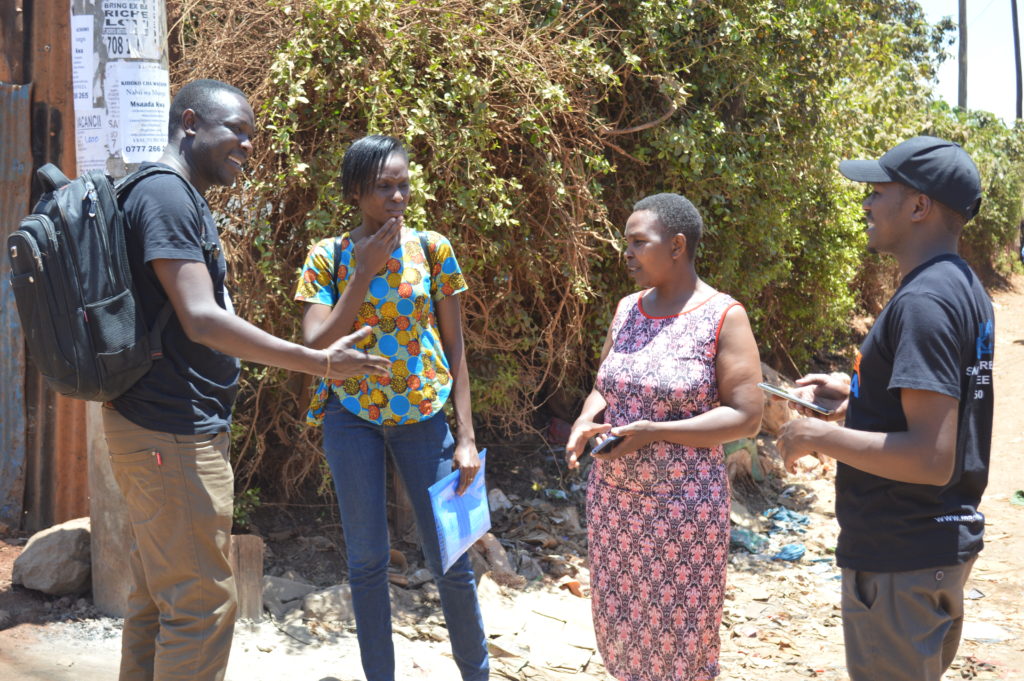 The mapping exercise commenced on Monday 17th September and each of the 6 teams was allocated a specific area to cover. The field work proceeded quite well and the mappers were well received in most of the schools they visited. The entire mapping exercise took a total of fourteen working days and despite the challenging task the mappers managed to cover all the schools in the designated wards. My team specifically mapped the highest number of schools since the schools were concentrated in the area. Â
The mapping exercise commenced on Monday 17th September and each of the 6 teams was allocated a specific area to cover. The field work proceeded quite well and the mappers were well received in most of the schools they visited. The entire mapping exercise took a total of fourteen working days and despite the challenging task the mappers managed to cover all the schools in the designated wards. My team specifically mapped the highest number of schools since the schools were concentrated in the area. Â
With the support of the community and leaders, this exercise has already covered more than 250 schools which are now on OpenStreetMap, and will soon be added to the Open Schools Kenya website. Please check back for more updates soon!
As the year 2018 has just began, everyone is busy writing resolutions, some reviewing what worked last year and what they need to change while others are writing new resolutions for the year. We at Map Kibera also took time to reflect on how the year 2017 was for us in terms of the work that we were able to do.
Security mapping/election monitoring
Una Hakika Project
The year began on a good note with the team in Map Kibera conducting a baseline survey for a project that they would be implementing in Kibera in partnership with the Sentinel Project. The project was dubbed Una Hakika? (Are you sure?), and the aim of the project was to assess and moderate the spread of rumours before, during and after the August election.

Una Hakika launch event at Undugu Ground in Kibera
With the August election drawing near, Map Kibera with the help of 3 students from University of Nairobi and JKUAT who were on internship through the Youth Mappers programme conducted a mapping exercise with the help of local community ambassadors drawn from the Una Hakika project.
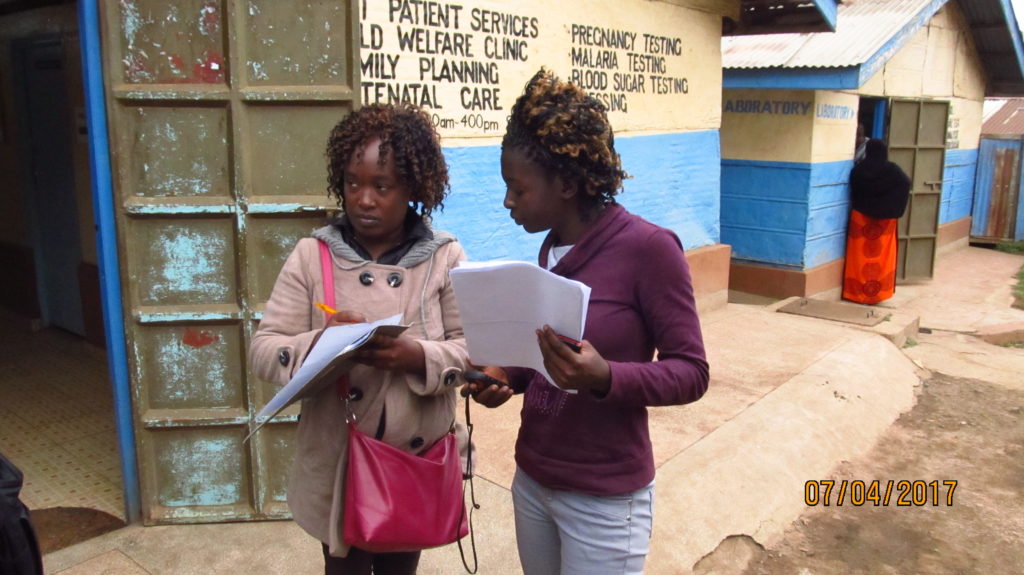
Lucy Fondo (on the left) and Phylister Mutinda collecting data in the field
This was to update the security map that was last updated during the 2013 elections. The printed copies of the maps were distributed to the local administrative officials as well as to NGOs that work in Kibera on peace initiatives.
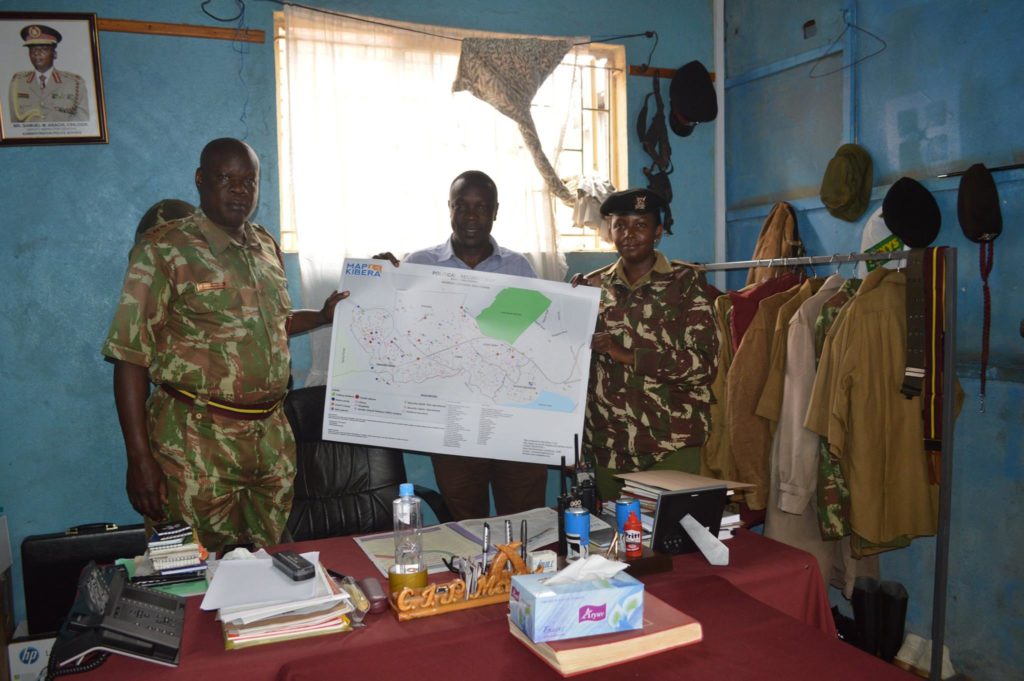
Joshua Ogure issuing a copy of the security map to Adminstration Police commandant
The other copies of the maps were distributed to community members. Read more here. The updated security map was also painted on the wall at a strategic point in Kibera where the community members and visitors would interact with it.
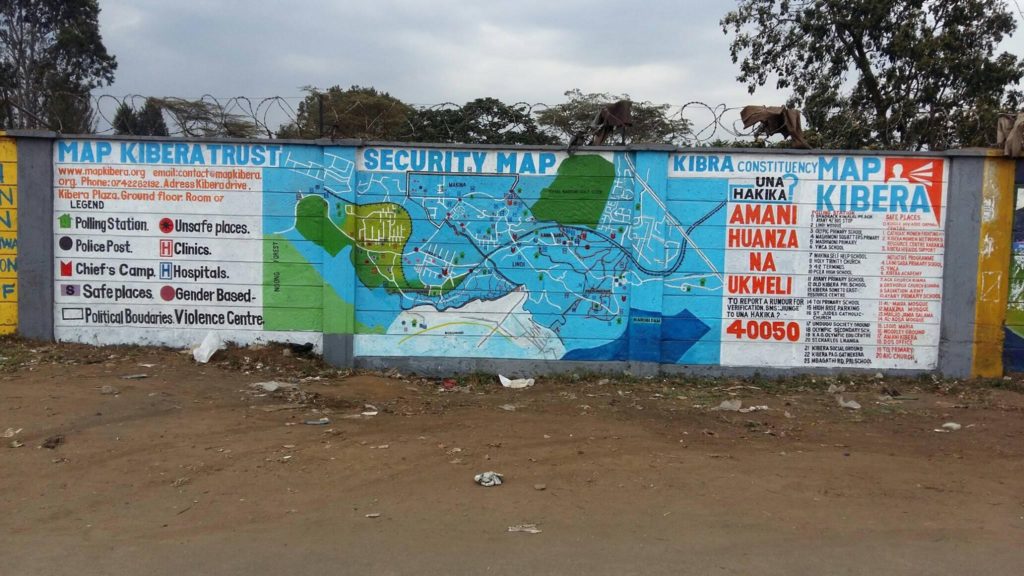
Updated Security map on the wall
During the August 8th election Map Kibera through the Una Hakika project also set up teams on various polling stations to report on the events as they were occurring. This was done through video coverage by the Kibera News Network team. The team was also supposed to report any issues by sending sms to the Una Hakika’s short code 40050.
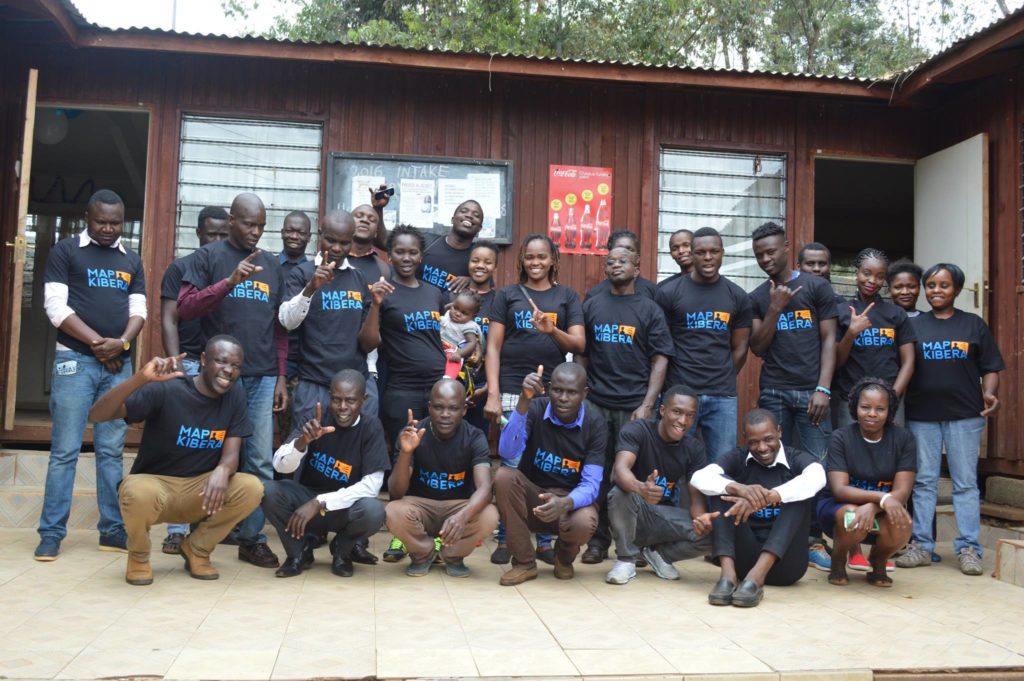
Citizen reporters trained for the elections
Video Coverage of Elections by KNN
The KNN team produced more than 50 videos for both August 8 elections and the repeat October 26 elections. At least one video went “viral” with more than 13,000 views: Kibera Supports Supreme Court Ruling.
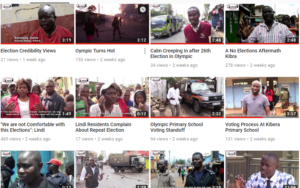
A screenshot of the videos produced by KNN during the election period
Repeat election
On 1st of October 2017 the Supreme Court Of Kenya nullified the August 8th Presidential election. The electoral body of Kenya was thereby asked to organize a fresh presidential election. This meant that our work on election monitoring wasn’t yet finished. So we organized and re-strategized to prepare for the fresh election. The period before the new set date for election saw a lot of demonstrations from the opposition team demanding changes on the electoral body before conducting another election. Kibera News Network documented some of these events, and even did interviews with some of the victims of police brutality after violence erupted immediately after Uhuru Kenyatta was declared the winner of the August 8th election. The IEBC set a new date for the repeat election to be 26th October. We monitored these elections afresh just as we did earlier.
Research
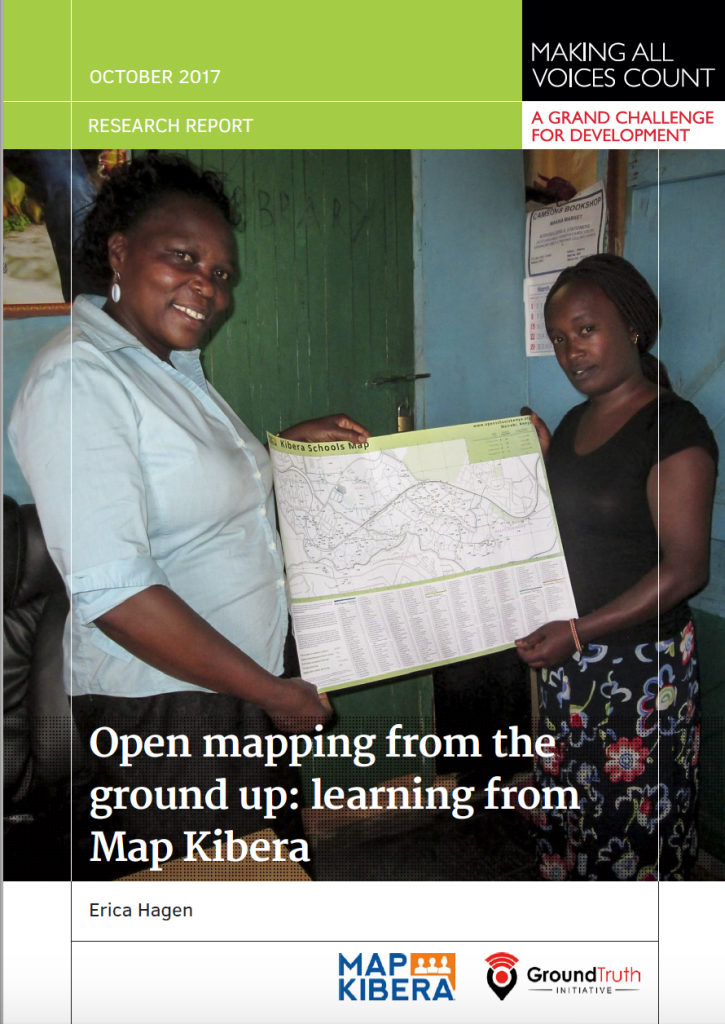 In the same year Erica Hagen, one of the co-founders of Map Kibera, was funded by Making All Voices Count to conduct a research on the impact of the work of Map Kibera in the local community and how the maps are being used by various local organizations, community based organizations, government offices and the community members. Key outcomes were that local officials had used our education maps to reach out to informal schools, build networks and extend resources to these schools. NGOs had also used other maps by Map Kibera to locate resources such as water and sanitation facilities. The research report can be read here.
In the same year Erica Hagen, one of the co-founders of Map Kibera, was funded by Making All Voices Count to conduct a research on the impact of the work of Map Kibera in the local community and how the maps are being used by various local organizations, community based organizations, government offices and the community members. Key outcomes were that local officials had used our education maps to reach out to informal schools, build networks and extend resources to these schools. NGOs had also used other maps by Map Kibera to locate resources such as water and sanitation facilities. The research report can be read here.
Sharing, Participating, Collaborating
The year 2017 also saw Map Kibera being recognized and invited to attend various international and national events to share about their work. Some of the meetings were: the High-Level Meeting on Data for Development in Africa held by the Kenya Government and Global Partnership for Sustainable Development Data (GPSDD); Buntwani 2017 organized by Open Institute, Making All Voices Count, Dlad and Data Zetu in Dar es salaam; the Data Pop course at UN Headquarters in Nairobi, and a radio interview at IQRA FM.
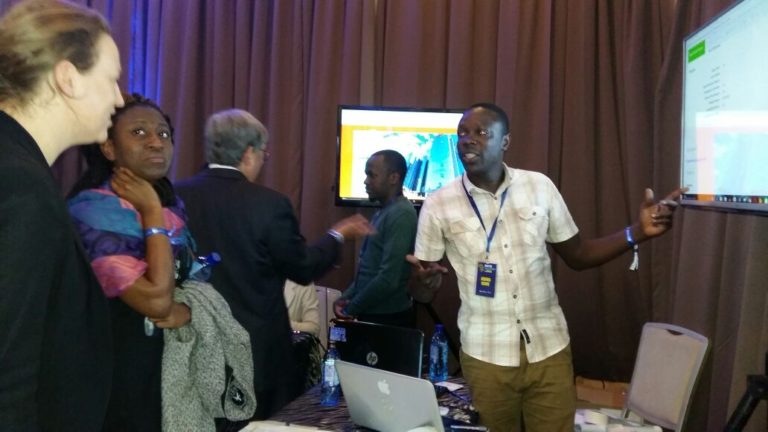
Joshua doing demonstration about Map Kibera and the open schools project at the High level meeting.
 ICT4D
For the second consecutive year Map Kibera has been invited to speak at the ICT4D conference. This year’s conference was held in Hyderabad, India and the theme for the conference was from innovation to impact. Zack Wambua represented the organization at the conference where he shared the impact of the Open Schools Kenya project. Zack also had an opportunity to visit one of the local organization Hyderabad Urban Lab to learn more about the work that they are doing around community participatory mapping in Hyderabad.
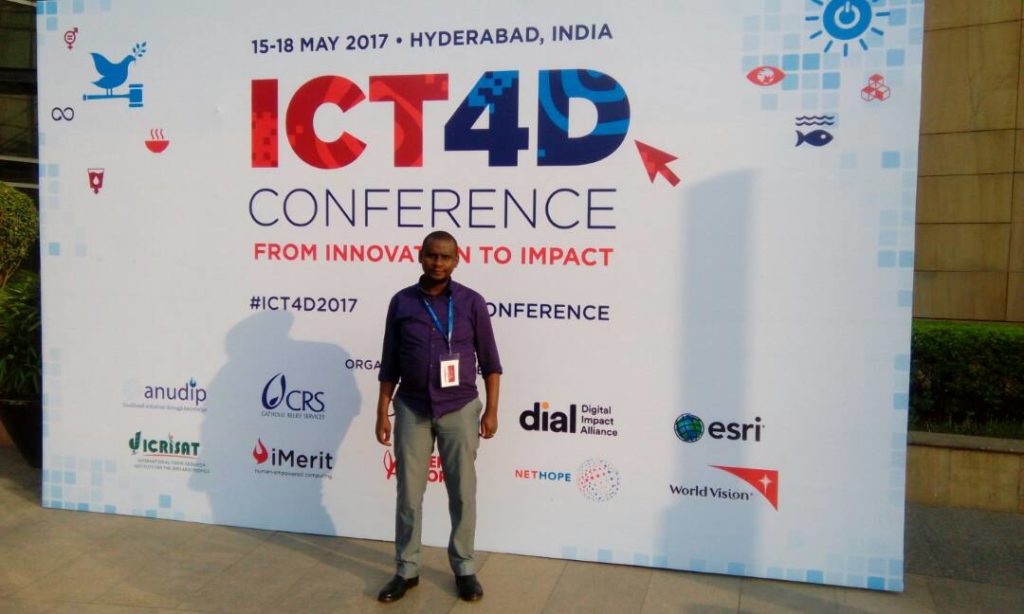
Zack Wambua at the ICT4D conference.
 State of the Map (SOTM) AFRICA
This was the first ever SOTM event to be held in Africa, and Map Kibera being one of the oldest users of OpenStreetMap in Africa were invited to share about their work on community mapping, a model that has been borrowed by many groups and organizations that use OSM. Joshua Ogure the project manager of Map Kibera travelled to Kampala, Uganda to represent the organization at the event. Read more here  http://www.mapkibera.org/blog/2017/07/21/my-experience-at-the-first-state-of-the-map-africa/
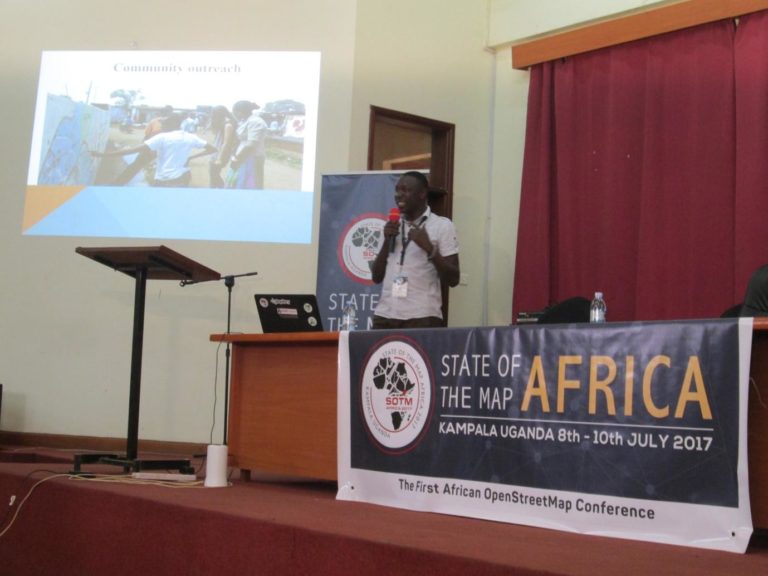
Joshua Presenting Map Kibera at SOTM Africa Kampala
SOTM Tanzania
After the successful SOTM Africa event, OSM teams in Tanzania led by Crowd2Map and Ramani Huria organized SOTM Tanzania. the event took place in Dar Es Salaam. Map Kibera was again called to assist with the planing of the event and also to share about their work during the conference. Zack Wambua travelled to Dar to represent the organization at the conference.

A group photo of all the attendees at SOTM Tanzania
Open Schools Kenya
In 2017Â Map Kibera kept up with changes to the Open Schools Kenya data. We along with our interns checked if the schools were still in the same location and if they had moved, we collected coordinates of their new location and updated the details on the site. We were also able to update school populations (for both teachers and students), changes in school management as well as any other co-curriculum activities that are offered in the schools. This was followed by an update to the website, where we added a search by location filter which enables you to view the schools’ data in both Kibera and Mathare, the two locations that we have rolled out the OSK work. Look for more changes and additional locations in OSK in 2018!
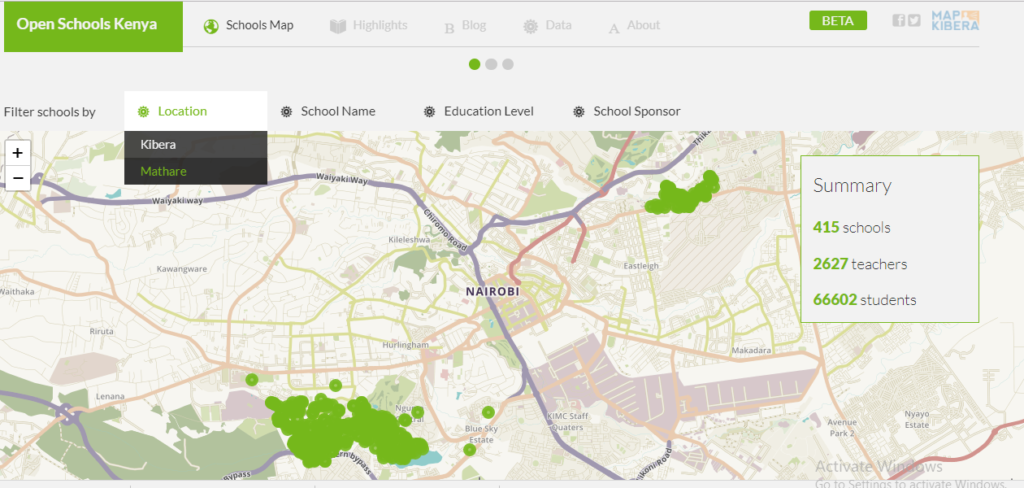
A screenshot of the updated Open Schools Kenya website with the new search by location feature
Open Schools Kenya has been recently updated, and we are now starting to add schools in Mathare! Working with Youth Mappers chapter at the University of Nairobi, Map Kibera has so far covered the “Mathare Village” area.  We are working to expand coverage to the entire Mathare slum, where Map Kibera has previously mapped and worked with citizen journalists (see Voice of Mathare and Map Mathare). OSK is also updated with new information on Kibera schools, including a number of closures, relocations, and new schools. Simply keeping the data current on the Kibera schools is a challenge, but schools are often in touch about changes. And, keeping our eyes and ears on the latest happenings in the community is after all what we do best.
The total number of mapped schools is now 415, including 355 in Kibera and 59 in Mathare. We hope to have all of Mathare covered in the next few months, and continue to expand coverage in 2018 to other areas of Nairobi and Kenya.
Please also see this recent research about Map Kibera for Making All Voices Count, which particularly notes OSK’s local impacts as a major achievement for open community data!
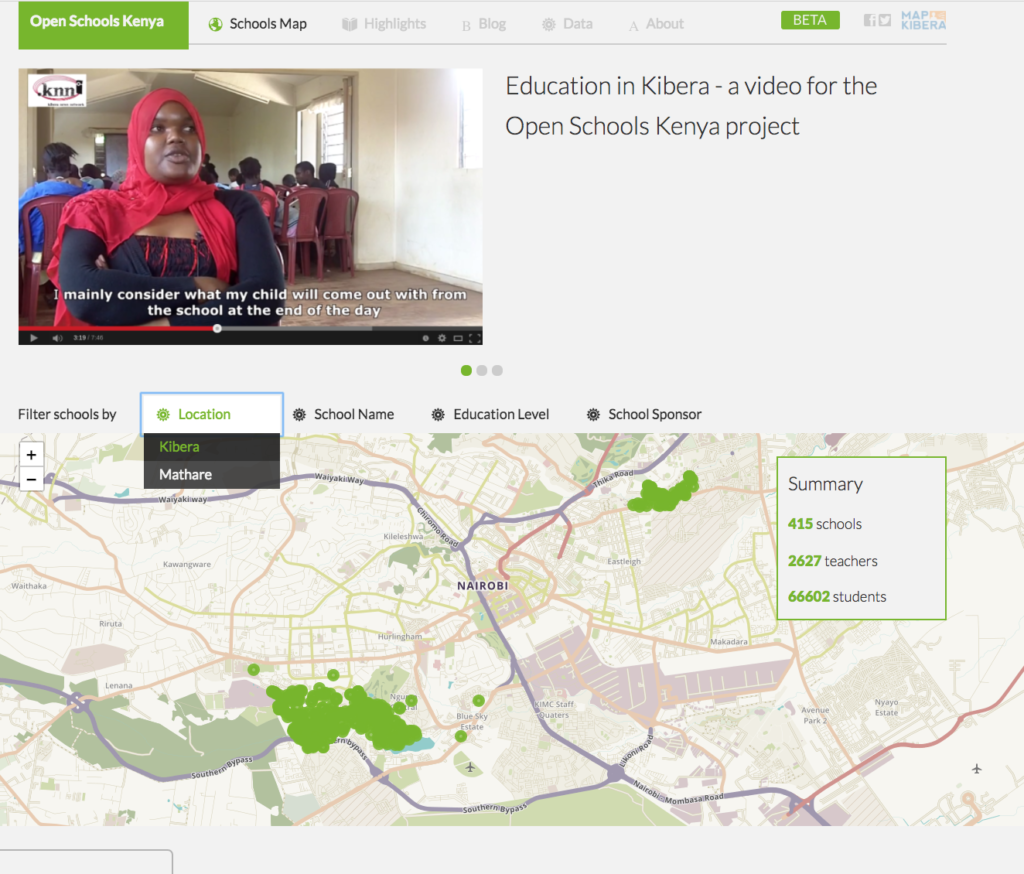
 We had a total of twelve mappers with seven of them being locals from the region, and the rest from the Map Kibera team. Lead mapper from Kangemi was Sharon Adhiambo, who had previously worked with Map Kibera on trainings while a member of Youth Mappers at Moi University. The selected wards were Kangemi, Kitusuru, Mountain View, and Parklands. The training started on Thursday 13th of September and we proceeded to the next day taking the trainees through OpenStreetMap, Open Data Kit (ODK) and Java OpenStreetMap (JOSM).
We had a total of twelve mappers with seven of them being locals from the region, and the rest from the Map Kibera team. Lead mapper from Kangemi was Sharon Adhiambo, who had previously worked with Map Kibera on trainings while a member of Youth Mappers at Moi University. The selected wards were Kangemi, Kitusuru, Mountain View, and Parklands. The training started on Thursday 13th of September and we proceeded to the next day taking the trainees through OpenStreetMap, Open Data Kit (ODK) and Java OpenStreetMap (JOSM). The mapping exercise commenced on Monday 17th September and each of the 6 teams was allocated a specific area to cover. The field work proceeded quite well and the mappers were well received in most of the schools they visited. The entire mapping exercise took a total of fourteen working days and despite the challenging task the mappers managed to cover all the schools in the designated wards. My team specifically mapped the highest number of schools since the schools were concentrated in the area. Â
The mapping exercise commenced on Monday 17th September and each of the 6 teams was allocated a specific area to cover. The field work proceeded quite well and the mappers were well received in most of the schools they visited. The entire mapping exercise took a total of fourteen working days and despite the challenging task the mappers managed to cover all the schools in the designated wards. My team specifically mapped the highest number of schools since the schools were concentrated in the area.  













